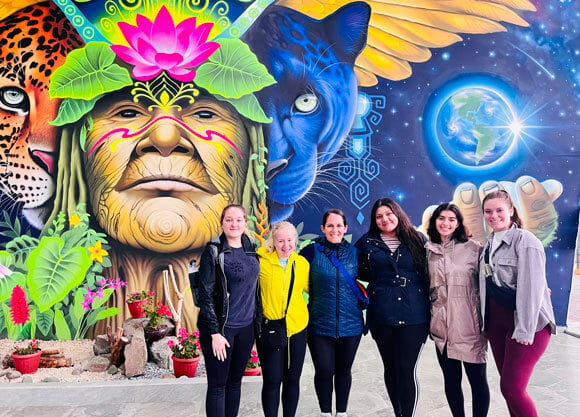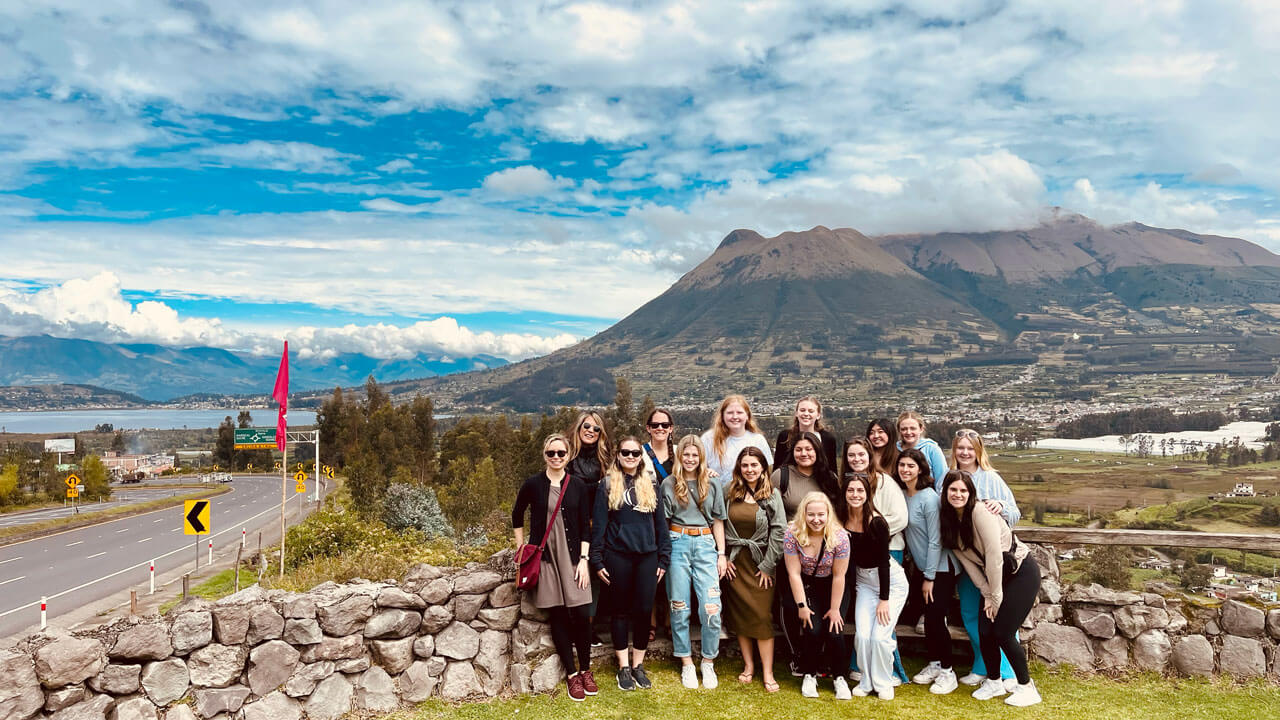
Students embrace cultural immersion in Ecuador global health program
January 23, 2023

January 23, 2023

It was the perfect start to her global learning program studying health care in Ecuador, Syme said.
A group of Quinnipiac students recently spent one week in Ecuador developing the basic vocabulary, phrases and cultural considerations necessary to communicate effectively with Spanish speakers in a variety of clinical settings. In a program that combines exposure to ancestral and traditional medical practices, the students lived with host families, participated in observational site rotations by shadowing health care professionals and practiced their Spanish language skills at local hospitals, clinics and cultural locations.
“At first, I thought, ‘What am I going to do? How am I going to live and work with these people if I can’t communicate with them?’” said Syme, a behavioral neuroscience major. “But it was a lot easier than I expected. We were able to communicate and as the days went on, I realized language wasn’t a barrier anymore. Everyone was so sweet and excited for us to be there and enjoy Ecuador.”

Syme, along with 13 of her fellow students, spent one week during winter break immersed in the culture and history of Ecuador’s vibrant capital city, Quito, located in the Andes Mountain range. Led by Director of Global Learning Erin Sabato, Associate Professor of Nursing Teresa Twomey and Associate Director of Global Public Health & Experiential Learning Amy Bellman Davis, the faculty-led course abroad provided an opportunity for students to develop the skills and appreciation for the use of culturally responsive communication methods in one of the most essential components of any community, its health care system.
“One of the best parts of this experience was seeing our students gain confidence in their Spanish skills,” reflected Sabato. “Some of the students were at a very introductory level in Spanish while some in the group were more fluent. But whether it was ordering at restaurants, late-night chats with their host families, or communication with the medical professionals they were shadowing — I saw tremendous growth in everyone’s ability to communicate in Spanish.”
While the blended cultural makeup of the global community continues to evolve, so has the ability of professionals to deliver health care services that meet the social, cultural and linguistic needs of patient populations. Through interactions with local health care providers in Ecuador, students experienced what it means to make a genuine impact in patient care while working alongside community members in the spirit of solidarity, collaboration and reciprocity.
The cohort included students representing an interdisciplinary range of health-related disciplines, including nursing, physical therapy, health sciences, and global public health. According to Sabato, this year’s program mirrored real-life settings with students from different disciplines learning to work together in a clinical setting.
“What made this year’s program unique was that it was two classes combined — Spanish for Health Professions and Health Promotion and Wellness — as well as students from our minor in Global Public Health. Occasionally when groups are combined, you can sense a divide, or the students stay grouped within their own classes or academic years,” said Sabato. “With this year's program, they blended together and truly had a cohesive learning experience. The group ranged from first-year to senior students, and they all learned from one another's experience.”
According to Sabato, one of the greatest aspects of the program is that students are exposed to a variety of people, settings and perspectives, all while experiencing the day-to-day life of local host families. In addition to gaining confidence communicating in Spanish within social and professional settings, the students were exposed to a holistic view of health care systems in Quito and how Ecuadorians access these services.
“Each student participated in observation medical rotations, so they were able to speak and engage with nurses, physicians, interns and other local and international students,” said Sabato. “They learned about the educational system in Ecuador through daily Spanish classes and experiences that helped turn lessons into practice. And we also visited a number of locations in Quito to learn about important historical and cultural aspects of the area where we were staying.”
For 3+3 Health Science/Physical Therapy accelerated dual-degree major Daniella Vetrano ’23, the opportunity to immerse herself into the Ecuadorian culture and deepen her global perspective on health care proved to be both professionally and personally impactful.
“I gained so much from this experience because I had the freedom and the privilege to try new things and build relationships with those around me including my teachers and peers at LatinoSchools and with my friends and professors,” said Vetrano.
“In some ways, I’m grateful that I didn’t know a lot of Spanish coming into this trip. It taught me how it feels to listen and understand some of the conversations at hand, while not being able to express my thoughts into words.”
Through her minor in global public health, Vetrano had previously participated in a virtual Ecuador program in the summer of 2022 that focused on women’s and children’s health.
“I remember one of the Ecuadorian professors told me how important the environment is to their culture and their livelihood,” said Vetrano. “When I saw there was a week-long study abroad in Ecuador focused on clinical rotations and practicing Spanish, I was so grateful to receive a second chance to go.”
In addition to exploring the city of Quito, the group traveled by cable car to the active volcano Volcan Pichincha, posed for pictures on the equator and visited Otavalo Market, the largest Indigenous market in Ecuador, just two hours from Quito in the town of Otavalo. The students also visited a local food market where they tried new fruits and vegetables while practicing their Spanish.
“We practiced our negotiating skills at the Otavalo market with vendors selling art, jewelry, clothing, decorations, kitchen towels and everything handmade,” said Vetrano, recalling her favorite moments from the trip. “I also had to get over my fear of heights to climb to the top of the bell tower at the Basilica Del Voto Nacional in Quito. When we made it to the top, the view was incredible. I remember someone who was waiting for his turn to go back down made a joke about how many stairs there were in Spanish, and we all laughed. This was the first time I felt that we were all thinking and feeling the same things. After this very small, shared moment with a stranger, I was more determined than ever to learn the language in hopes of making more connections.”
One of the most meaningful experiences for the group was a visit to Fundación Jambi Huasi, a clinic in the town of Otavalo. The clinic combines western and traditional medicine to ensure accessible health care where all community members can feel both seen and heard while their traditions and values are respected.
“There's really no one way to define health care in Ecuador. That’s why I think it's important to provide students with an experience where they're learning from local experts and the people living in the communities they serve,” said Sabato. “We’re inquisitive, but we approach every interaction with respect and humility. And our students come away transformed and eager to serve at home.”
Quinnipiac Today is your source for what's happening throughout #BobcatNation. Sign up for our weekly email newsletter to be among the first to know about news, events and members of our Bobcat family who are making a positive difference in our world.
Sign Up Now